|
 |
| Adult found at about 9,500 ft elevation, Sierra Nevada Mountains, Inyo County © Mark Girardeau |
 |
 |
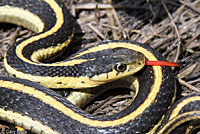 |
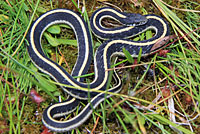 |
| |
Adult, Placer County |
|
Adult, Plumas County |
 |
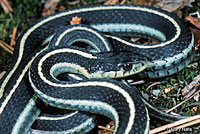 |
 |
 |
| Adult with blue coloring, 2,300 ft., Mt. St. Helena, Napa County |
Adult, Plumas County |
 |
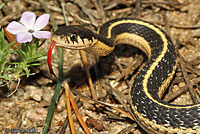 |
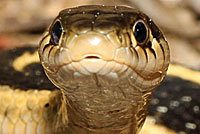 |
 |
| Adult, 8,900 ft., Alpine County |
Adult, 7,000 ft., Sierra Nevada Mountains, Calaveras County |
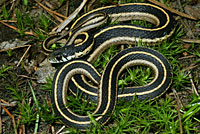 |
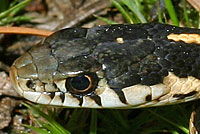 |
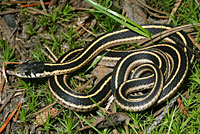 |
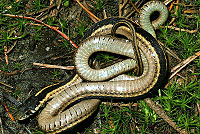 |
| Adult, 7,000 ft., Sierra Nevada Mountains, Calaveras County |
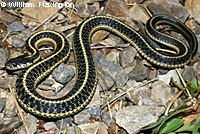 |
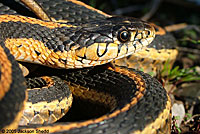 |
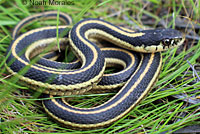 |
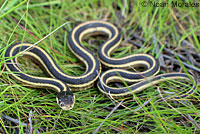 |
Adult, 5915 ft. elevation Warner Mountains, Modoc County
© William Flaxington |
Adult, Sierra Nevada Mountains, Butte County © 2005 Jackson Shedd |
Adult, found near Stockton, San Joaquin County © Noah Morales |
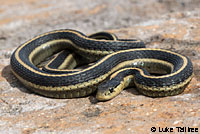 |
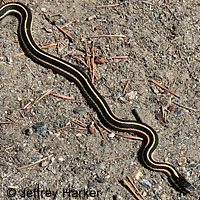 |
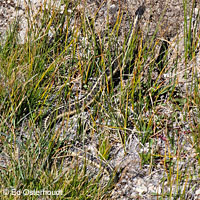 |
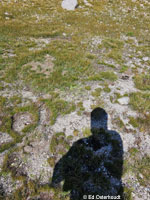 |
Adult, northeast Sonoma County.
© Luke Talltree |
Adult, 7,800 ft. elevation,
Tuolumne County © Jeffrey Harker |
Adult found at about 11,645 feet in elevation (3,549 m) in Tulare County above Guitar Lake. This is most likely an elevation record for the subspecies. The snake is seen in its habitat in the picture on the right above and to the left of the shadow.
© Ed Osterhoudt |
| |
|
|
|
| Mountain Gartersnakes from the Disjunct San Bernardino Mountains Population |
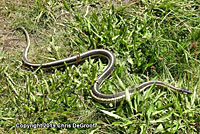 |
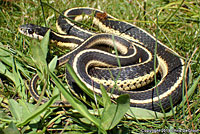 |
 |
 |
| Adult, San Bernardino Mountains, San Bernardino County © Chris DeGroof |
Adult, San Bernardino Mountains, San Bernardino County © Chris DeGroof |
Adult, 6,723 ft.elevation San Bernardino Mountains, San Bernardino County
© William Flaxington |
Adult, 6,723 ft.elevation San Bernardino Mountains, San Bernardino County
© William Flaxington |
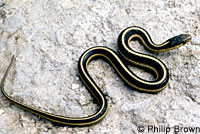 |
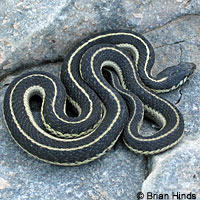 |
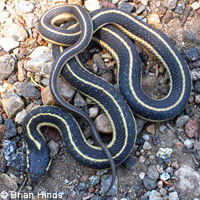 |
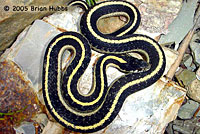 |
| Adult, San Bernardino Mountains, San Bernardino County © Philip Brown |
Adult, San Bernardino Mountains, San Bernardino County © Brian Hinds |
Adult, San Bernardino Mountains, San Bernardino County © Brian Hinds |
Adult, Sierra Nevada Mountains, Plumas County © 2005 Brian Hubbs |
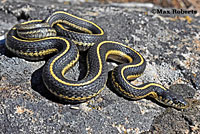 |
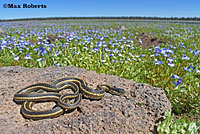 |
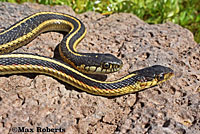 |
|
Adult, Modoc County
© Max Roberts |
Adult, Modoc County
© Max Roberts |
Top: Mountain Gartersnake
Bottom: Valley Gartersnake
Both adults from Modoc County
© Max Roberts |
|
| |
|
|
|
| Juveniles |
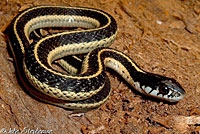 |
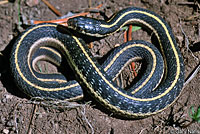 |
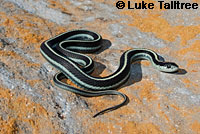 |
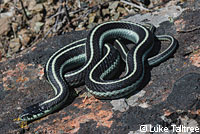 |
Neonate, 5,000 ft. Sierra Nevada Mountains, El Dorado County
© John Stephenson |
Juvenile, Sierra Nevada Mountains, Mariposa County |
Sub-adult with blue coloring, northeast Sonoma County © Luke Talltree |
Sub-adult with blue coloring, northeast Sonoma County © Luke Talltree |
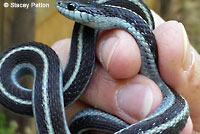 |
|
|
|
| Sub-adult with blue coloring, Mendocino County near Willets © Stacey Patton |
|
|
|
| |
|
|
|
| Breeding Adults |
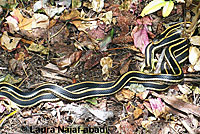 |
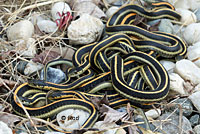 |
|
|
| Two adults mating in April in Sacramento County © Laura Najaf-abadi |
A mass of breeding snakes in Placer County in early May © Rod |
|
|
| |
|
|
|
| Intergrades |
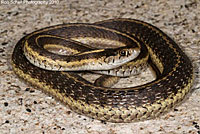 |
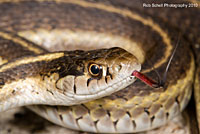 |
 |
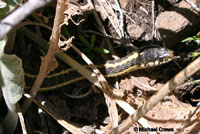 |
This snake from Jackass Meadows in the Sierra Nevada mountains, Tulare County, is an intergrade of T. e. elegans and T. e. vagrans. © Rob Schell
Intergrades of these two subspecies occur along the southern and southeastern edge of the Sierras.
|
Intergrade of T. e. elegans and
T. e. vagrans.
Found in northern Siskiyou and Modoc counties and in south central Oregon, this intergrade was once considered a unique subspecies: Thamnophis elegans biscutatus - Klamath Gartersnake.
More pictures of this intergrade snake can be viewed here. |
Intergrade of T. e. elegans and
T. e. vagrans found on the
east side of the Warner Mountains in Modoc County
© Michael Crews |
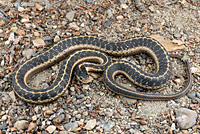 |
|
|
|
This snake from east of the Sierra Nevada Mountains in Mono County is a mix ofT. e. elegans and T. e. vagrans.
© Ryan Sikola |
|
|
|
| |
|
|
|
| Feeding |
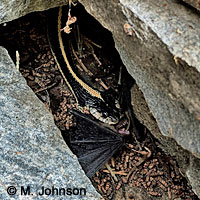 |
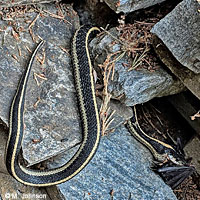 |
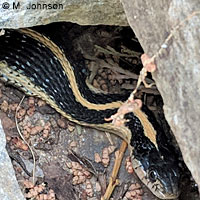 |
|
| Adult eating a bat. You can see the bulge of the bat inside the snake in the last picture. Plumas County © M. Johnson |
|
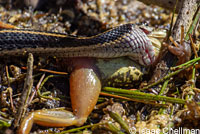 |
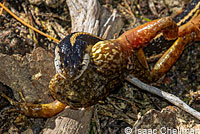 |
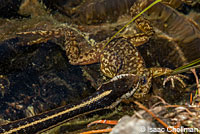 |
 |
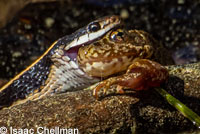 |
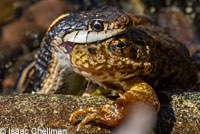 |
 |
|
| The pictures above show a Mountain Gartersnake discovered by Spencer Williams that is preying on a juvenile Sierra Nevada Yellow-legged Frog in Eldorado County. The last picture shows the frog being swallowed head first. © Isaac Chellman |
 |
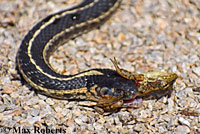 |
|
| Adult, Madera County, catching a trout in a drying puddle. © Grigory Heaton |
Adult eating a juvenile Southern Mountain Yellow-legged Frog in
Tulare County © Max Roberts |
|
| |
|
|
| Habitat |
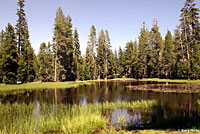 |
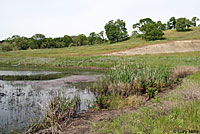 |
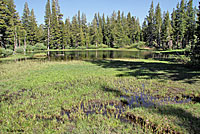 |
 |
Habitat, mountain pond in coniferous forest, 7,000 ft. Sierra Nevada Mountains, Calaveras County
|
Habitat, Placer County |
Habitat, 8,800 ft., Alpine County |
Habitat, 8,800 ft., Alpine County |
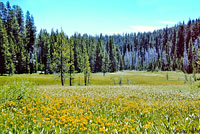 |
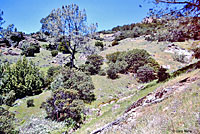 |
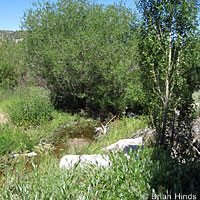 |
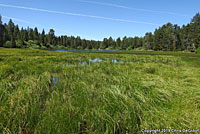 |
| Habitat, high elevation wet meadow in coniferous forest, Sierra Nevada Mountains, Mariposa County |
Habitat, rocky drainage in mixed woodlands, 2,300 ft., Napa County |
Habitat, San Bernardino Mountains, San Bernardino County © Brian Hinds |
Habitat, San Bernardino Mountains, San Bernardino County © Chris DeGroof |
| |
|
|
|
| Short Videos |
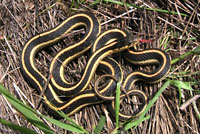 |
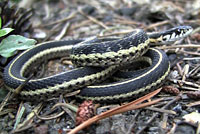 |
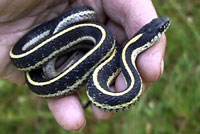 |
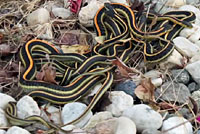 |
| A Mountain Gartersnake crawls around a pond in Placer County. |
A small Mountain Gartersnake next to a high mountain pond in Alpine County. |
A Mountain Gartersnake at a creek in the Plumas County mountains. |
A mass of breeding snakes in Placer County in early May © Rod.
Several males are trying to breed with a female who is somewhere in this pile of writhing snakes. |
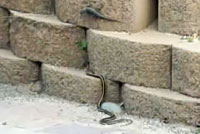 |
 |
|
|
| These two videos show a Placer County Northwestern Fence Lizard appearing to taunt a garter snake (a Mountain Gartersnake is my guess, because it lacks red.) The lizard keeps moving down towards the snake but when the snake moves towards the lizard, apparently trying to catch it for dinner, the lizard runs up the wall away from the snake. © Rod |
|
|
|
|
|
|
|
Description |
Not Dangerous - This snake may produce a mild venom that does not typically cause death or serious illness or injury in most humans, but its bite should be avoided.
Commonly described as "harmless" or "not poisonous" to indicate that its bite is not dangerous, but "not venomous" is more accurate since the venom is not dangerous. (A poisonous snake can hurt you if you eat it. A venomous snake can hurt you if it bites you.)
Long-considered non-venomous, discoveries in the early 2000s revealed that gartersnakes produce a mild venom that can be harmfull to small prey but is not considered dangerous to most humans, although a bite may cause slight irritation and swelling around the puncture wound. Enlarged teeth at the rear of the mouth are thought to help spread the venom.
|
| Size |
Thamnophis elegans measures 18 - 43 inches in length (46 - 109 cm).
|
| Appearance |
A medium-sized slender snake with a head barely wider than the neck and keeled dorsal scales.
Some scale averages: Average of 8 upper labial scales, occasionally 7, scales 6 and 7 are enlarged, higher than wide. Average of 10 lower labial scales. The front and rear pair of chin shields are equal in length. The internasals are wider than long and not pointed in front. Average scale count at mid-body is 21, rarely 19. |
| Color and Pattern |
Ground color is a dark olive-brown or black with no red markings.
There are
3 well-defined light stripes on the back and sides:
The dorsal stripe is yellow, orange, or white.
The lateral stripes may be paler. Underside is pale with few markings, and is sometimes darker in the center. |
Key to Identifying California Gartersnake Species
|
| Life History and Behavior |
Active in daylight. Chiefly terrestrial - not as dependant on water as other gartersnake species, but more likely to be found near water.
|
| Defense |
If frightened when picked up, this snake will often strike repeatedly and release cloacal contents.
When frightened, this species will sometimes seek refuge in vegetation or ground cover, but it will also crawl quickly into water and swim away from trouble. |
| Diet |
Western Terrestrial Gartersnakes - Thamnophis elegans - eat a wide range of prey (among the widest of any snake species - Rossmann, et al. 1996.) The prey depends on the size of the snake (large snakes tend to eat larger prey, small snakes can only eat smaller prey) and what prey is available. Populations found on the humid North Coast where slugs are abundant are genetically predisposed to eat slugs, while populations in dryer areas where slugs are less common refuse to eat slugs when they are offered. (Rossmann, et al. 1996.)
Diet includes: invertebrates such as slugs, leeches, snails, and earthworms; fish; amphibians - tadpoles, frogs, (and probably salamanders); snakes and lizards;
birds; and small mammals such as mice and voles (and bats as you can see in the pictures above.)
At high elevations in the Sierra Nevada, Mountain Gartersnakes rely almost exclusively on amphibians for food, mostly Sierran Treefrogs.
Toxic Newts
Thamnophis elegans terrestris has been found in San Luis Obispo County eating Taricha torosa, which are deadly poisonous to most predators.
(Feldman, Hansen, & Sikola. Herpetological Review 51[3] 2020.)
It's possible that T. e. elegans is also able to develop a resistance to newt toxins.
The Bay Area is the Center of an Evolutionary Race Between Hungry Snakes and Toxic Newts.
by Anton Sorokin. Bay Nature, April 6, 2022
Gartersnakes Can Become Poisonous
There is evidence that when Common Gartersnakes (Thamnophis sirtalis) eat Rough-skinned Newts (Taricha granulosa) they retain the deadly neurotoxin found in the skin of the newts called tetrodotoxin for several weeks, making the snakes poisonous (not venomous) to predators (such as birds or mammals) that eat the snakes. Since California Newts (Taricha torosa) also contain tetrodotoxin in their skin, and since gartersnake species other than T. sirtalis also eat newts, it is not unreasonable to conclude that any gartersnake that eats either species of newt is poisonous to predators.
Williams, Becky L.; Brodie, Edmund D. Jr.; Brodie, Edmund D. III (2004). "A Resistant Predator and Its Toxic Prey: Persistence of Newt Toxin Leads to Poisonous (Not Venomous) Snakes." Journal of Chemical Ecology. 30 (10): 1901–1919.) https://doi.org/10.1023/B:JOEC.0000045585.77875.09
|
| Reproduction |
Mating occurs primarily in spring
Females are ovoviviparous. After mating with a male they carry the eggs internally until the young are born live from July to Sepember.
|
| Habitat |
Inhabits streamsides, springs, mountain lakes, in grassland, meadows, brush, woodland, and coniferous forest.
|
| Geographical Range |
In California, the subspecies Thamnophis elegans elegans - Mountain Gartersnake, is found throughout the Sierra Nevada Mountains, through most of the northern part of the state except for the outer Coast Ranges south at least as far as Mt. St. Helena. There is an isolated population in the San Bernardino Mountains.
The subspecies ranges out of the state north into Oregon and to the edge of northern Nevada.
Most range maps showing subspecies of T. elegans, show T. e. elegans occurring in the Central Valley near Lodi. Previously I changed my maps to show T. e. terrestris there based on the one bright red snake from Lodi seen above, but discussions with a herpetologist in that area have convinced me that they are T. e. elegans. It's likely that the wild-caught Lodi specimen was transported there.
The species Thamnophis elegans - Western Terrestrial Gartersnake, ranges widely from the California coast north through most of northern California, Oregon, Washington, Idaho and Montana, into Canada, including Vancouver Island, British Columbia, Alberta and Saskatchewan, and east into the states of Wyoming, Colorado, Utah, Arizona and New Mexico and just barely making it into South Dakota, Nebraska, and Oklahoma. Many isolated populations exist, including those in the San Bernardino Mountains and one in Baja California Norte, Mexico (the San Pedro Martir Gartersnake.)
|
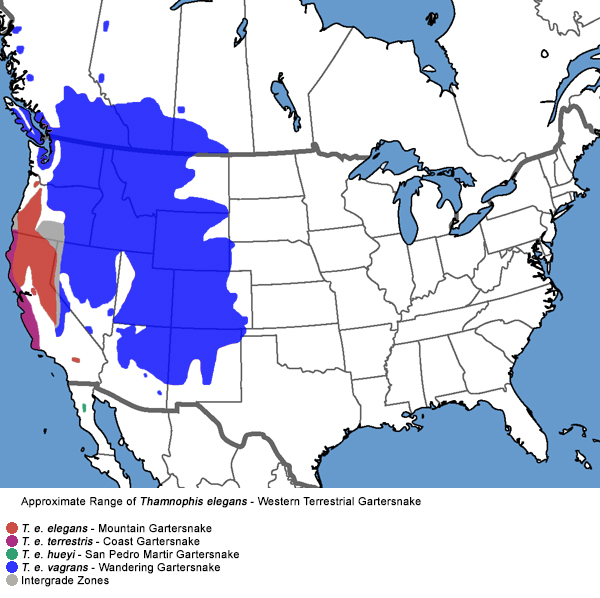 |
| Elevational Range |
T. elegans
In 2008, Cathryn J. Wise and others showed that the longstanding elevation record of 13,100 ft. (3,990 m) in Colorado for Thamnopis elegans, based on specimens of T. e. vagrans collected in 1960, is questionable, and that a more reliable record for the species is from 12,002 ft. (3658 m) on Humphrey's Peak in Arizona.
(Herpetological Review 39(3), 2008)
T. e. elegans
Recorded from 11,515 feet (3,510 m) at Pinchot Pass in Fresno County, and from 11,645 feet (3,549 m) above Guitar Lake in Tulare County, which is the apparent elevation record. Photos of the Tulare Co. specimen found by Ed Osterhoudt can be seen above.
|
| Notes on Taxonomy |
T. e. vagrans intergrades with T. e. elegans in northeast California in Modoc and eastern Siskiyou counties and in south central Oregon (this snake was formerly classified as the subspecies Thamnophis elegans biscutatus - Klamath Gartersnake. Intergrades with T. e. elegans also occur along the southern and southeastern edge of the Sierras.
Three subspecies of Thamnophis elegans are found in California - T. e. vagrans - Wandering Gartersnake, T. e. e.egans - Mountain Gartersnake, and T. e. terrestris - Coast Gartersnake.
Rossman, Ford, and Seigel (1996) emphasize that a detailed study of geographic variation throughout the range of Thamnophis elegans is badly needed.
Bronikowski and Arnold (2001, Copeia 2001:508-513) found several clades within T. elegans that do not always follow the subspecies boundaries, and concluded that there was no support for the race terrestris. Presumably, the former T. e. terrestris snakes become T. e. elegans.
Hammerson (1999, Amphibians and Reptiles of Colorado. 2nd ed. Univ. of Colorado Press) synonymized T. e. arizonae and T. e. vascotanneri but retained three subspecies, T. e. vagrans, T. e. elegans, and T. e. terrestris.
Alternate and Previous Names (Synonyms)
Thamnophis elegans elegans - Mountain Gartersnake (Stebbins 1966, 1985, 2003, Stebbins & McGinnis 2012)
Thamnophis elegans elegans (Stebbins 1954)
Thamnophis ordinoides elegans - Elegant Garter Snake (Eutainia elegans; Eutainia vagrans; Eutaenia infernalis, part; Eutaenia elegans lineolata; Eutaenia elegans brunnea; Eutaenia couchii; Thamnopis infernalis, part; Tropidonotus tri-vittatus; Eutaenia elegans couchii, part; Tropidonotus ordinatus infernalis; Tropidonotus ordinatus ver. couchii; Thamnophis vagrans; Thamnophis parietalis, part; Eutaenia elegans vagrans; Eutaenia hammondi, part; Thamnophis elegans, part; Eutaenia elegans infernalis. Boyd's Garter Snake; Pacific Garter Snake; Wandering Garter Snake; Hammond's Garter Snake; Single-striped Garter Snake; Green Garter Snake;, Western Garter Snake) (Grinnell and Camp 1917)
Thamnophis elegans elegans - Mountain Gartersnake (Baird and Girard, 1853)
Boyd's garter snake
California garter snake
Formerly-recognized Klamath Garter Snake subspecies:
Thamnophis elegans biscutatus - Klamath Garter Snake (Stebbins 1961, 1985)
Thamnophis elegans biscutatus (Stebbins 1954)
Thamnophis elegans biscutatus - Klamath garter snake (Cope 1883)
Cope's garter snake
|
| Conservation Issues (Conservation Status) |
| Not known to be threatened, but gartersnakes have been negatively impacted by competition with introduced bullfrogs and non-native fish in some areas. High-altitude populations of this snake may decline if populations of high-altitude frogs continue to decline. |
|
| Taxonomy |
| Family |
Colubridae |
Colubrids |
Oppel, 1811 |
| Genus |
Thamnophis |
North American Gartersnakes |
Fitzinger, 1843 |
| Species |
elegans |
Western Terrestrial Gartersnake |
(Baird and Girard, 1853) |
Subspecies
|
elegans |
Mountain Gartersnake |
(Baird and Girard, 1853) |
|
Original Description |
Thamnophis elegans - (Baird and Girard, 1853) - Cat. N. Amer. Rept., Pt. 1, p. 34
from Original Description Citations for the Reptiles and Amphibians of North America © Ellin Beltz
|
|
Meaning of the Scientific Name |
Thamnophis - Greek - thamnos - shrub or bush, and ophis - snake, serpent
elegans - Latin - fine or elegant -- "delicately carinated"
from Scientific and Common Names of the Reptiles and Amphibians of North America - Explained © Ellin Beltz
|
| Other California Gartersnakes |
T. a. atratus - Santa Cruz Gartersnake
T. a. hydrophilus - Oregon Gartersnake
T. a. zaxanthus - Diablo Range Gartersnake
T. couchii - Sierra Gartersnake
T. gigas - Giant Gartersnake
T. e. terrestris - Coast Gartersnake
T. e. vagrans - Wandering Gartersnake
T. hammondii - Two-striped Gartersnake
T. m. marcianus - Marcy's Checkered Gartersnake
T. ordinoides - Northwestern Gartersnake
T. s. fitchi - Valley Gartersnake
T. s. infernalis - California Red-sided Gartersnake
T. s. tetrataenia - San Francisco Gartersnake
|
|
More Information and References |
California Department of Fish and Wildlife
Rossman, Douglas A., Neil B, Ford, & Richard A. Siegel. The Garter Snakes - Evolution and Ecology. University of Oklahoma press, 1996.
Hansen, Robert W. and Shedd, Jackson D. California Amphibians and Reptiles. (Princeton Field Guides.) Princeton University Press, 2025.
Stebbins, Robert C., and McGinnis, Samuel M. Field Guide to Amphibians and Reptiles of California: Revised Edition (California Natural History Guides) University of California Press, 2012.
Stebbins, Robert C. California Amphibians and Reptiles. The University of California Press, 1972.
Flaxington, William C. Amphibians and Reptiles of California: Field Observations, Distribution, and Natural History. Fieldnotes Press, Anaheim, California, 2021.
Samuel M. McGinnis and Robert C. Stebbins. Peterson Field Guide to Western Reptiles & Amphibians. 4th Edition. Houghton Mifflin Harcourt Publishing Company, 2018.
Stebbins, Robert C. A Field Guide to Western Reptiles and Amphibians. 3rd Edition. Houghton Mifflin Company, 2003.
Behler, John L., and F. Wayne King. The Audubon Society Field Guide to North American Reptiles and Amphibians. Alfred A. Knopf, 1992.
Powell, Robert., Joseph T. Collins, and Errol D. Hooper Jr. A Key to Amphibians and Reptiles of the Continental United States and Canada. The University Press of Kansas, 1998.
Bartlett, R. D. & Patricia P. Bartlett. Guide and Reference to the Snakes of Western North America (North of Mexico) and Hawaii. University Press of Florida, 2009.
Bartlett, R. D. & Alan Tennant. Snakes of North America - Western Region. Gulf Publishing Co., 2000.
Brown, Philip R. A Field Guide to Snakes of California. Gulf Publishing Co., 1997.
Ernst, Carl H., Evelyn M. Ernst, & Robert M. Corker. Snakes of the United States and Canada. Smithsonian Institution Press, 2003.
Taylor, Emily. California Snakes and How to Find Them. Heyday, Berkeley, California. 2024.
Wright, Albert Hazen & Anna Allen Wright. Handbook of Snakes of the United States and Canada. Cornell University Press, 1957.
Joseph Grinnell and Charles Lewis Camp. A Distributional List of the Amphibians and Reptiles of California. University of California Publications in Zoology Vol. 17, No. 10, pp. 127-208. July 11, 1917.
|
|
|
The following conservation status listings for this animal are taken from the April 2024 State of California Special Animals List and the April 2024 Federally Listed Endangered and Threatened Animals of California list (unless indicated otherwise below.) Both lists are produced by multiple agencies every year, and sometimes more than once per year, so the conservation status listing information found below might not be from the most recent lists. To make sure you are seeing the most recent listings, go to this California Department of Fish and Wildlife web page where you can search for and download both lists:
https://www.wildlife.ca.gov/Data/CNDDB/Plants-and-Animals.
A detailed explanation of the meaning of the status listing symbols can be found at the beginning of the two lists. For quick reference, I have included them on my Special Status Information page.
If no status is listed here, the animal is not included on either list. This most likely indicates that there are no serious conservation concerns for the animal. To find out more about an animal's status you can also go to the NatureServe and IUCN websites to check their rankings.
Check the current California Department of Fish and Wildlife sport fishing regulations to find out if this animal can be legally pursued and handled or collected with possession of a current fishing license. You can also look at the summary of the sport fishing regulations as they apply only to reptiles and amphibians that has been made for this website.
This snake is not included on the Special Animals List, which indicates that there are no significant conservation concerns for it in California.
|
| Organization |
Status Listing |
Notes |
| NatureServe Global Ranking |
|
|
| NatureServe State Ranking |
|
|
| U.S. Endangered Species Act (ESA) |
None |
|
| California Endangered Species Act (CESA) |
None |
|
| California Department of Fish and Wildlife |
None |
|
| Bureau of Land Management |
None |
|
| USDA Forest Service |
None |
|
| IUCN |
|
|
|
|
 Red: Range of this subspecies in California
Red: Range of this subspecies in California











































































